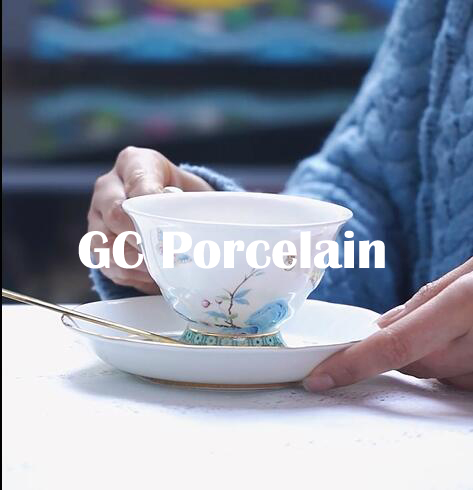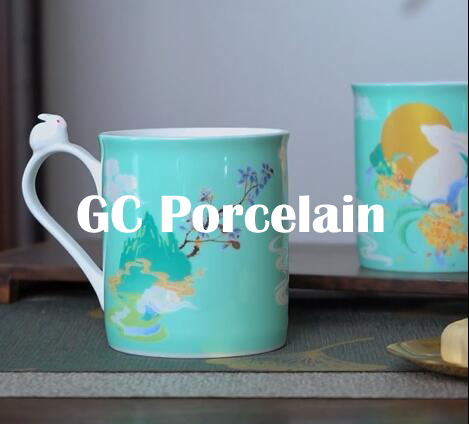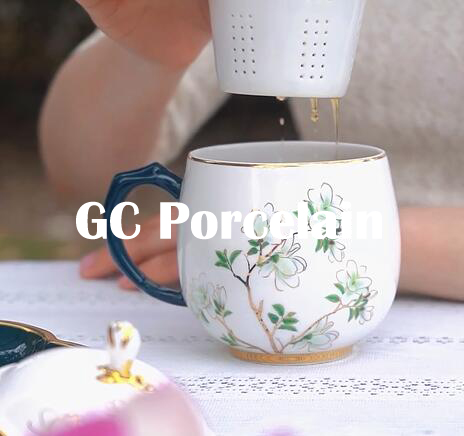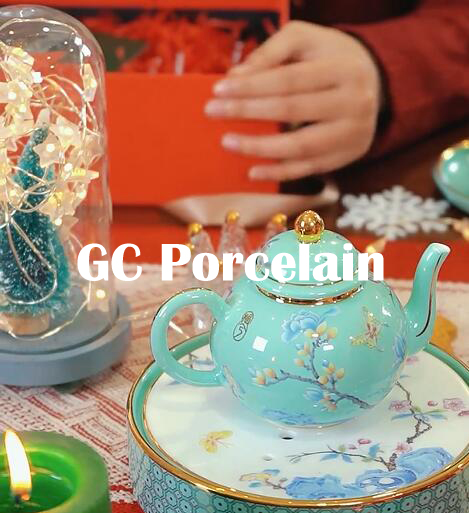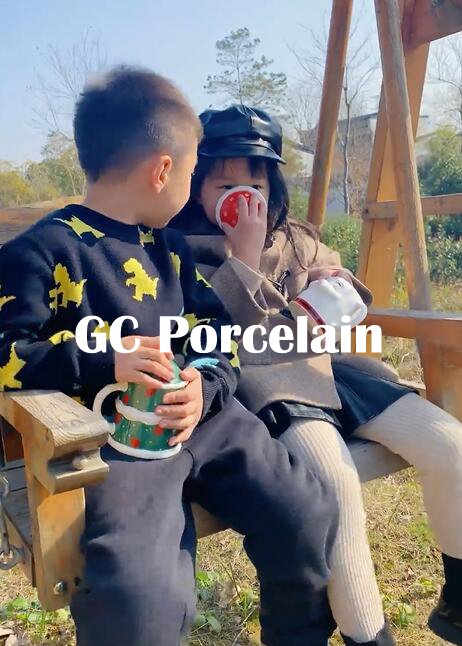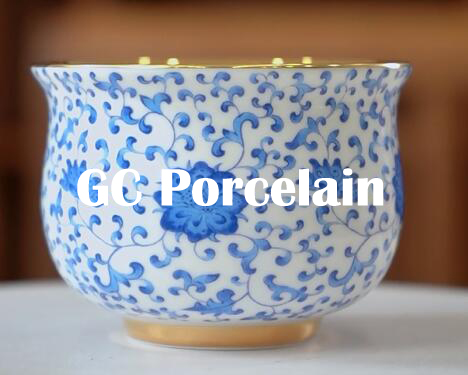White Porcelain
Jingdezhen white porcelain is different from other white porcelains based on the ingenuity and creativity of the four traditional famous porcelains of Jingdezhen: blue and white porcelain, blue and white porcelain, pastel porcelain and color glaze porcelain.
Late Eastern Han Dynasty Yue kiln of celadon began our country porcelain pioneer; Tang Dynasty Xing kiln of white porcelain is the beginning of our country calendar white porcelain production of the southern blue and northern white situation. Such as the Tang Dynasty Lu Yu "Tea Classic" said: "lamp, Yuezhou on, Dingzhou second, Wuzhou second, Yuezhou second, Shouzhou second, Hongzhou second. Or Xingzhou in Yuezhou on, but it is not. Xing porcelain like silver, Yue porcelain like jade, Xing is not as good as Yue one; Xing porcelain like snow, Yue porcelain like ice, Xing is not as good as Yue two; Xing porcelain white and tea color Dan, Yue porcelain green and tea color green, Xing is not as good as Yue three".
Tang dynasty white porcelain is developed on the basis of the Sui dynasty. Since the Xing kiln white porcelain kiln site was discovered in Hebei Lincheng, after ceramics academics and archaeological research, the quality of Xing kiln white porcelain and the level of craftsmanship have a more in-depth understanding of the Xing kiln "type of snow" white porcelain is not true to its name. Ding kiln since the beginning of the Tang has also been firing white porcelain, and then developed into one of the five famous kilns in the Song Dynasty. Into the Five Dynasties, the southern white porcelain famous production area Jingdezhen has gradually emerged, thus breaking the Tang Dynasty kilns "South Green North White" situation.
Xing kiln porcelain tiles contain 60%~65% silica, 28%~35% alumina, while the content of iron oxide and titanium dioxide is very low. It can be seen that it used more kaolin clay as biscuit material. The whiteness of the glaze >70%, which is caused by the low content of iron trioxide and titanium dioxide in the blank material. The reflectivity of the glaze at different wavelengths are both high and small differences, so it shows a more pure white color. Xing kiln white porcelain firing temperature difference, 1260 ℃ ~ 1370 ℃, but its firing temperature of 1350 ℃. So some of the raw firing or over-fired, which is related to the north at the time of the bun kiln firing.
In addition: Xing kiln white porcelain is also used in cosmetic clay to improve the whiteness of the product, white porcelain bowl using a single tray mounted firing and coarse porcelain bowl into a stacked tray into the kiln firing. In short, the outstanding achievements of the Tang Dynasty Xing kiln white porcelain in the craft mainly depends on the quality of pure porcelain raw materials, the structure of reasonable and complete kilns and furnaces, as well as highly skilled porcelain craftsmen's fine work. From the Xing kiln remains in some fine white porcelain, not only at that time was highly praised, that is, measured by modern standards, also not lose the title of fine white porcelain.
During the Five Dynasties, white porcelain with hard texture and pure glaze color was already produced in Yangmeiting, Shihuwan and Huangditou in Jingdezhen.
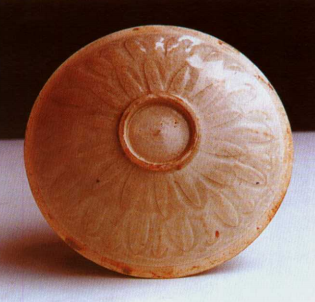
Yangmeiting White Porcelain Dish

Xing kiln white porcelain
The chemical composition of its porcelain tires are high silica, silica about 77%, and lower alumina, only 16% or more, potassium oxide and sodium oxide content of about 3%, its composition and now Jingdezhen porcelain stone crushed and washed individuals made of chemical composition is very similar, so it can be regarded as a single stone individuals made of porcelain. Because of this high silica blanks sintering temperature range is narrower, it is easy to deform in high-temperature firing. The chemical composition of the glaze, calcium oxide content of more than 10%, potassium oxide and sodium oxide content is low, about 3%, so it belongs to the "gray glaze".
During the Jingde period of the Song Dynasty (AD 1004-1007), before the Jingdezhen kiln, also known as Raozhou kiln, firing white porcelain, and celadon. Due to the high amount of iron in the raw materials, the use of reducing flame firing, so that the tire three-valent iron ions into two-valent iron ions, the formation of porcelain glaze white with the unique tone of green. In the Song Dynasty and before, Jingdezhen porcelain billet is the use of ceramics as a class of raw materials, its firing temperature is not high and firing range is very narrow, the firing rate is not high; into the Yuan Dynasty, the court set up a royal kiln field in Jingdezhen, the quality of porcelain put forward the "white as jade" requirements, and the product specifications are getting bigger and bigger. This means that to increase the sense of jade must be improved in the body of the glass phase content, the need to increase the firing temperature of porcelain. But a single ceramic stone billet in raising the firing temperature after the body is prone to soft collapse, high-temperature deformation, product qualification rate is greatly reduced. Later, Jingdezhen potters in Yao Li Ma Cangshan discovered kaolin clay, kaolin clay introduced into the blanks, began to use the binary formula blanks. Kaolin clay in the billet in the high temperature firing can make the billet in the generation of more mullite crystals, in the case of more glass phase can still prevent the high temperature deformation, improve the billet firing temperature, widen the range of firing temperature, greatly improve the yield of the product. Since then, jingdezhen porcelain material has undergone qualitative changes, for jingdezhen porcelain status to lay a broad foundation.
Blue and White Porcelain
Blue and white porcelain is one of the four traditional porcelain in Jingdezhen, has a long history, known as the "jewel of the porcelain" of the name. Jingdezhen blue and white porcelain originated in the Yuan Dynasty.
Since the "blue and white porcelain" craze, people have raised the question of the origin of blue and white porcelain. There are two main representative points of view in China, as follows:
"gradual change": the number of people who hold this view more, they believe that blue and white porcelain is the use of put material for painting and decoration under the glaze painted porcelain, so under the glaze and the use of put material is the two basic elements of the process, these two elements in the Tang dynasty has basically have. Tang Dynasty Changsha kilns have been used as copper and iron minerals in the color under the glaze, firing a successful underglaze painted porcelain. The Song Dynasty Magizhou kiln underglaze colored porcelain has reached a very high level. Yangzhou, Jiangsu Tang City site found in the Tang Dynasty with blue colored porcelain pillow fragments, the Tang Sancai blue color shows that the Tang put material has begun to apply, and Longquan Jinsha Pagoda, Zhejiang Province and Shaoxing Huancui Pagoda unearthed in the Song Dynasty blue-colored ceramic fragments, shows that the Song Dynasty has been a more mature blue-and-white porcelain. Yuan dynasty Jingdezhen blue and white mainly by the influence of Jizhou kiln, and Jizhou kiln from the magnetic kiln. So China's blue and white porcelain from the Tang and Song and Yuan, a long, long, continuous.1. "gradual change": the number of people who hold this view more, they believe that blue and white porcelain is the use of put material for painting and decoration under the glaze painted porcelain, so under the glaze and the use of put material is the two basic elements of the process, these two elements in the Tang dynasty has basically have. Tang Dynasty Changsha kilns have been used as copper and iron minerals in the color under the glaze, firing a successful underglaze painted porcelain. The Song Dynasty Magizhou kiln underglaze colored porcelain has reached a very high level. Yangzhou, Jiangsu Tang City site found in the Tang Dynasty with blue colored porcelain pillow fragments, the Tang Sancai blue color shows that the Tang put material has begun to apply, and Longquan Jinsha Pagoda, Zhejiang Province and Shaoxing Huancui Pagoda unearthed in the Song Dynasty blue-colored ceramic fragments, shows that the Song Dynasty has been a more mature blue-and-white porcelain. Yuan dynasty Jingdezhen blue and white mainly by the influence of Jizhou kiln, and Jizhou kiln from the magnetic kiln. So China's blue and white porcelain from the Tang and Song and Yuan, a long, long, continuous.
"Mutant theory": those who hold this theory believe that Jingdezhen "Yuan dynasty blue and white porcelain is difficult to relate to the above relics, probably directly affected by Persia, is to meet the needs of the Semyon and overseas trade and the production of mutant products". And that, at that time, Jingdezhen, white and green fine white porcelain is ideal for the use of blue and white decorative porcelain; and with the "northern craftsmen southward" and into the Jingdezhen of the magnetic kiln craftsmen, in the Persian underglaze blue pottery under the influence of the inspiration and, at ease with the blue and white painting. The blue and white porcelain is the beginning of the Yuan Emperor back to the Yuan court tribute to the Hui Hui merchants of one of the items, and for the main export porcelain marketed through the Islamic region.2. "Mutant theory": those who hold this theory believe that Jingdezhen "Yuan dynasty blue and white porcelain is difficult to relate to the above relics, probably directly affected by Persia, is to meet the needs of the Semyon and overseas trade and the production of mutant products". And that, at that time, Jingdezhen, white and green fine white porcelain is ideal for the use of blue and white decorative porcelain; and with the "northern craftsmen southward" and into the Jingdezhen of the magnetic kiln craftsmen, in the Persian underglaze blue pottery under the influence of the inspiration and, at ease with the blue and white painting. The blue and white porcelain is the beginning of the Yuan Emperor back to the Yuan court tribute to the Hui Hui merchants of one of the items, and for the main export porcelain marketed through the Islamic region.
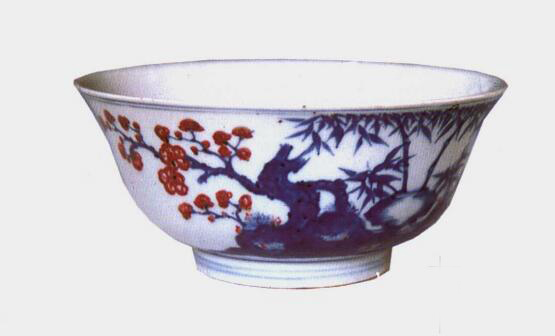
Qing Dynasty, Qianlong - Bowl, red under glaze
Glazed Red Porcelain
Glaze red porcelain is a kind of underglaze painted porcelain with copper oxide as coloring agent. Its production is the glaze with raw materials to add a higher content of copper oxide (than the general copper red glaze several dozen times higher) mixed with fine grinding into the color material, painted on the billet, and then glazed with transparent glaze, in the kiln by a strong reduction flame at high temperatures and become. After firing, under the glaze to form a red and white pattern, contrasting artistic effect, rather than the whole body of the red glaze. The combination of underglaze red and blue materials for underglaze painting, the porcelain produced is called underglaze red porcelain. Glazed red is Jingdezhen porcelain workers in the Yuan Dynasty, one of the important invention.
Jiangxi provincial museum collection of "to yuan wu yin" blue and white glazed red porcelain, is the earliest known yuan dynasty glazed red porcelain. It proves that in the "to yuan wuyin" (or to yuan four years, 1338) has been a glazed red porcelain production, because the production of glazed red difficult, it is not like the blue and white as a large number of production.
Early glazed red porcelain can only be fired in the kiln, now with the improvement of technology and kiln structure improvements, especially the extensive use of gas, glazed red porcelain firing has not been a problem.
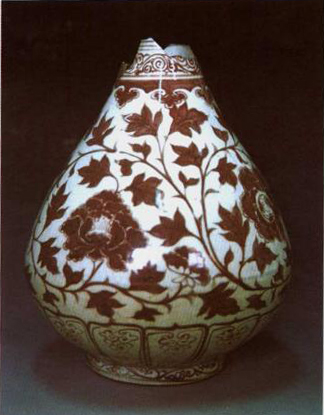
Ming Dynasty - Red Glazed Porcelain
Color Glazed Porcelain
Color glazed porcelain its decorative origin from the Shang Dynasty colored pottery. Yuan dynasty jingdezhen imitation of jiun kiln copper red glazed porcelain has been successful, become another new species of jingdezhen. But due to the difficulty of firing, so the production is very small, heirloom and unearthed Yuan dynasty red glazed ware is even more rare. 1988 Jingdezhen Ceramic Archaeological Research Institute in Zhushan excavation of Ming and Qing dynasty imperial kiln factory relics, found a large number of Yuan dynasty blue and copper-red glazed porcelain remains. After their further research, confirmed that the Zhushan area for the Yuan Dynasty Furlong Porcelain Bureau of the location, and replicated many of the Yuan Dynasty Furlong Porcelain Bureau of porcelain.
Although the Gu Lan glaze already appeared in the Tang Three Colors, it was not until the Yuan Dynasty at Jingdezhen that a high-temperature Gu Lan glaze was produced, thus adding to the variety of high-temperature color glazes.
During the Ming and Qing Dynasties, Jingdezhen color glazes collected the great achievements of famous porcelains from all over the world, and the technology of color glaze production continued to be refined, and then created such famous color glazes as sacrificial red, Lang kiln red, kiln change flower glaze, and aureole glaze, which were famous in the world for their unique national characteristics.
Early color-glazed porcelain, especially copper-red glazed ware can only be fired in the wood kiln, now with the improvement of technology and kiln structure, especially the extensive use of gas, color-glazed porcelain firing has become very common.

glaze
Blue and White Porcelain
The unique blue and white porcelain Linglong porcelain is the first in the white porcelain billet carved out in the shape of rice-like eyelets, and then take the blue and white porcelain with the same underglaze decoration, glaze glaze filling the billet on the rice-like eyelets, which is filled with glaze rice-like eyelets after high-temperature firing, became crystal clear Linglong eye. Therefore, blue and white porcelain is also known as "rice hole porcelain".
Conclusion
Porcelain is a material between porcelain and earthenware, hard but not as hard as real porcelain. Each of these materials has its own characteristics, and all are symbols of China's long history of culture. These types of ceramics have played an important role in Chinese history and culture, demonstrating the mastery of Chinese craftsmanship and traditional aesthetic values.
If you have any questions or need to custom dinnerware service, please contact our Email:info@gcporcelain.com for the most thoughtful support!

